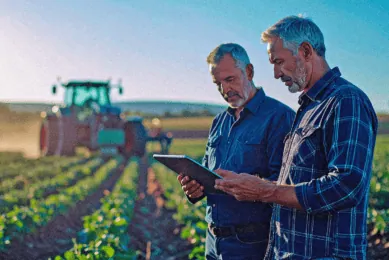Can AI-driven agritech startups solve shortages in crop production?

A fertilizer shortage is threatening the success of the world’s crops and could lead to widespread food shortages, experts say. In addition, labor shortages and an increasing need for advanced agritech tools are rampant. Evgeny Savin, co-founder of Green Growth explains how agritech startups can help.
The 20th century saw incredible advances in crop yields and production, but the 21st century is boldly taking this even further. More than ever, all processes are centered around the field, all data is generated about the land and all solutions are aimed toward input and output distribution optimization – growing more products at higher quality with fewer inputs.
While many processes are monitored and controlled from the software embedded into the machinery being used, such as John Deere’s Operations Center or CLAAS telematics, a great many startups offer separate solutions that either give new tools and generate better data, help save on existing subscription costs, help with the time and effort spent operating with existing data, or can do all of those things at the same time.
This has also led to successful startups being acquired by the existing farming equipment giants to help strengthen their infrastructure and end-user results.
Breaking down the technology
Let’s break down the most essential aspects which need to be covered by truly innovative IT solutions. Here are the technological aspects, the profits, and the ways to exceptional growth.
1. Land monitoring
The land most farmers work with is vast. Whether a farm owner has 500 or 50,000 Ha, monitoring land productivity day-by-day is difficult without monitoring it from above. Usually, this is done via satellites that monitor the Earth with radar and optical sensors, while drones are also now regularly used in agriculture, too.
When aggregating this data, a range of useful indices can be plotted. For example, the most common is the Normalized Difference Vegetation Index or NDVI index, which shows the amount of green mass on every single point in the field at this moment.
Given the range of software that allows monitoring fields from satellites and/or drones, one needs to choose wisely based on subscription costs, support presence in the region, the user interface, and types of integration possible with other apps, platforms, and data.
2. Farm management
Hundreds of processes are happening on the farm on a daily basis. Fuel and inputs need to be purchased in advance, contractors must be paid, field operations require experienced control, crop rotation needs optimization, amongst plenty more.
Without the storage of all this data in a single place, making sense of it all can become quite messy. Therefore, a farm management system (FMS) has become a must for every modern farmer. When choosing the best solution, one also needs to pay attention to local support and importantly, to the integrations available. In addition, popular FMS solutions usually also include land monitoring, but not at the advanced level that separate solutions offer.
3. Machinery data aggregation
When all the processes are set up, inputs purchased and salaries ready to be paid, the actual farming starts. Dozens or even hundreds of machines cruise around the land cultivating, fertilizing, and harvesting. Collecting huge amounts of data and aggregating it all gives invaluable insight.
For example, yield monitoring tools, when aggregated over two years along with crop rotation cycles, give essential insight into the consistent productivity zones and surface the results of various experiments conducted during the season. Having all of this information to hand, much of which was largely unavailable before, becomes an essential part of the decision-making processes, without which little true next-level progress can be achieved.
4. Machinery control
We now know much more about the land than we did before, have made decisions on optimizing the processes, and we’re now ready to jump into the next season with new knowledge and ideas. All of these decisions need to be presented as updated directions for the machinery and farming processes: how to till, how to distribute fertilizer more efficiently, and how to optimize it all to save fuel. Once the new data is analyzed, the software embedded with the machine’s electronics is uploaded with new instructions, so the farming is done with newfound precision.
Conclusion
There is a vast array of solutions for every single process on the market. Each company does its part effectively in a bid to be genuinely useful, and usually, does improve on what was done before.
Having dozens of software solutions and paying dozens of subscriptions is not what the end-user wants
However, in the end, having dozens of software solutions and paying dozens of subscriptions is not what the end-user wants. The big challenge? To connect everything into one or two main solutions and get results with the single push of a button. That is why big integration initiatives from the main players in the market are so important, and why it is truly possible to still achieve next-level results from land that has already seen massive improvements over the last few decades with modern machinery.
Join 17,000+ subscribers
Subscribe to our newsletter to stay updated about all the need-to-know content in the agricultural sector, two times a week.



